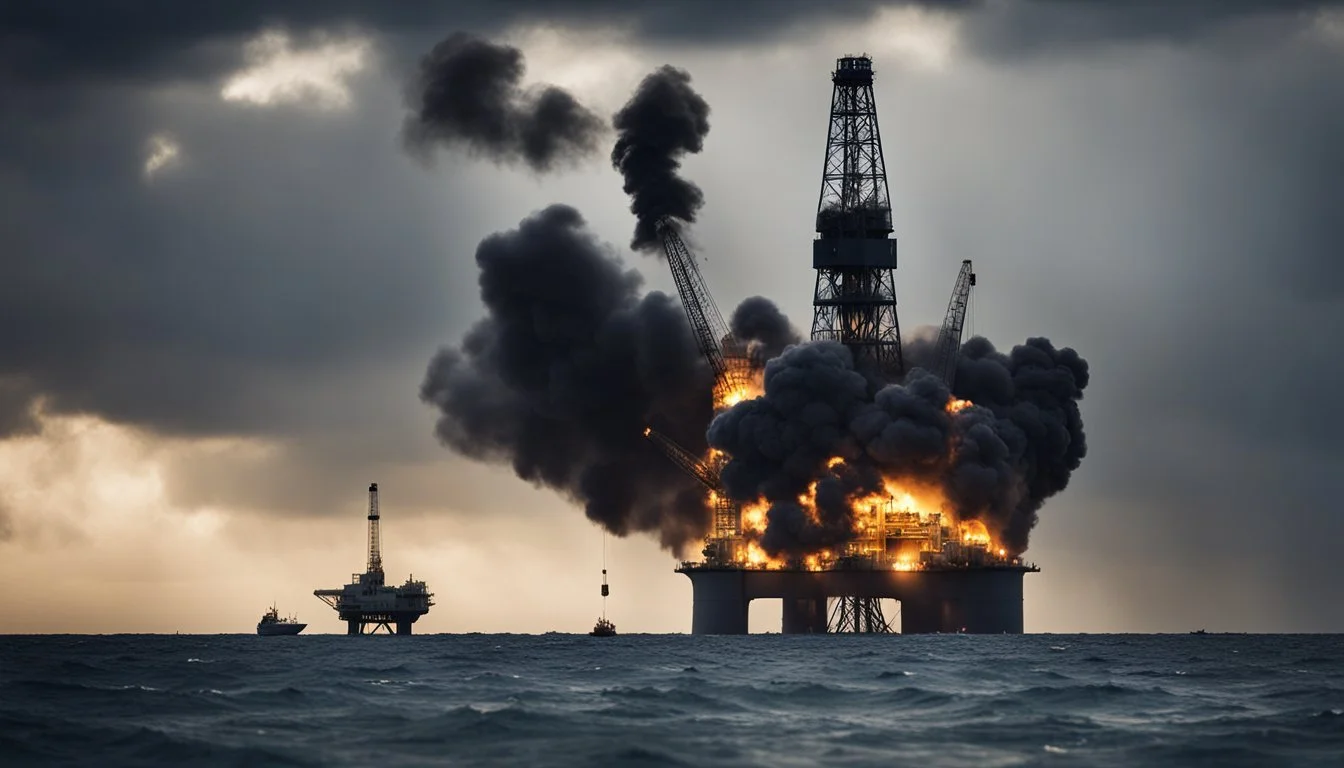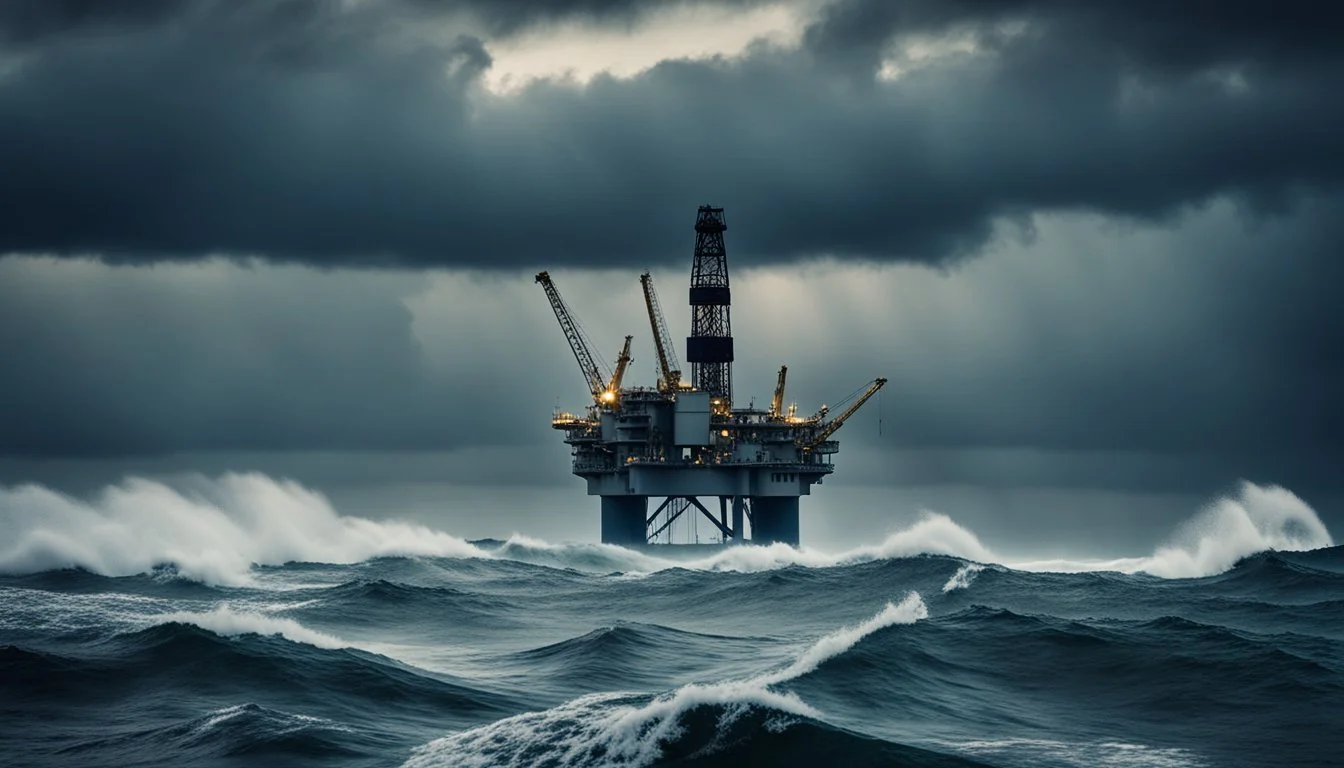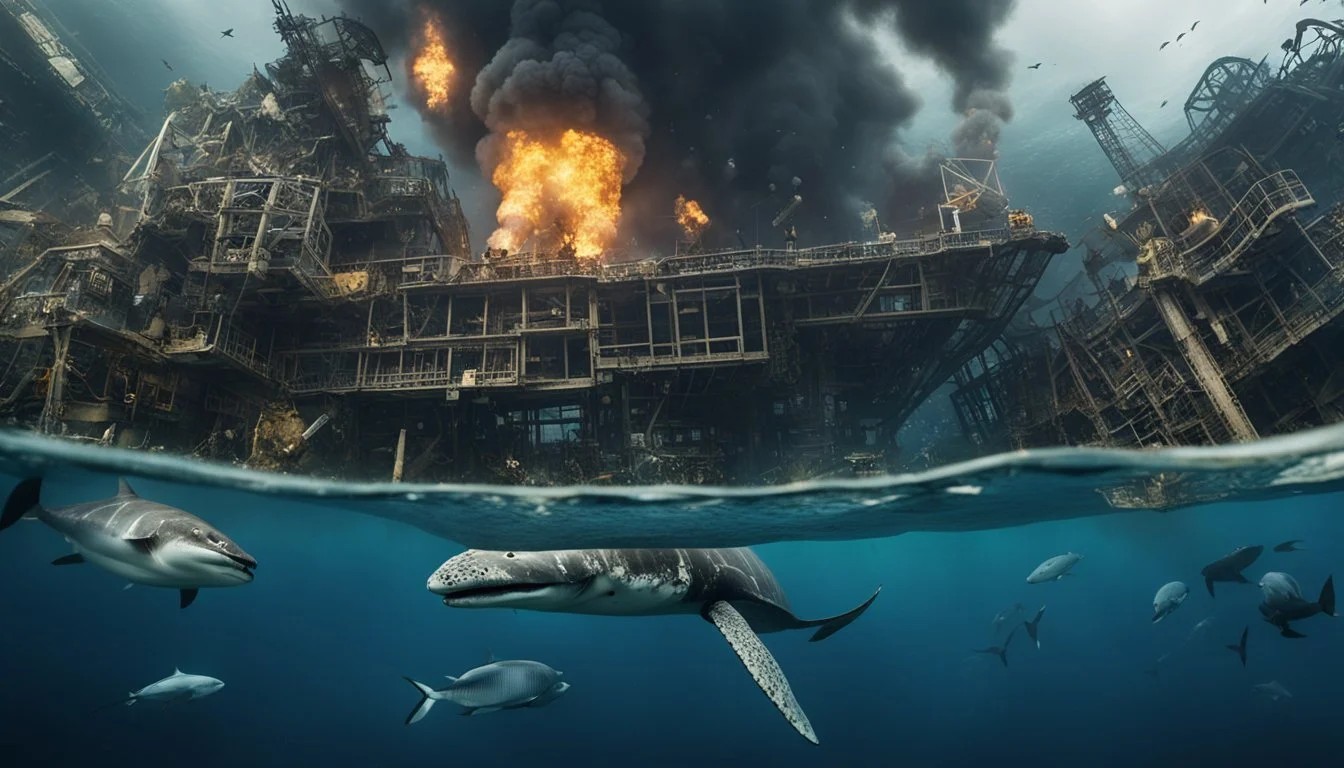ProPublica Exposes Oil Industry Secrets in Deepwater Horizon Investigation
The Deepwater Horizon oil spill of 2010 stands as one of the most catastrophic environmental disasters in American history. ProPublica, a non-profit newsroom known for investigative journalism, played a crucial role in uncovering the truth behind this devastating event. Their in-depth reporting revealed a pattern of safety failures and cost-cutting measures at BP that contributed to the disaster, challenging the company's narrative and exposing a troubling history of accidents.
ProPublica's approach to investigating the Deepwater Horizon incident exemplifies the vital role of environmental watchdogs in holding corporations accountable. The newsroom's detailed analysis of BP's past accidents and safety record provided crucial context for understanding the factors that led to the Gulf of Mexico spill. This thorough examination of corporate practices and their environmental consequences demonstrates the power of investigative journalism in uncovering hidden truths and promoting transparency.
The Deepwater Horizon cover-up, as exposed by ProPublica and other investigative efforts, highlights the importance of vigilant environmental monitoring and reporting. By delving into BP's history and examining the aftermath of the spill, ProPublica shed light on the complex interplay between corporate interests, environmental protection, and public safety. Their work serves as a reminder of the ongoing need for rigorous oversight and the critical role that independent journalism plays in safeguarding our environment.
Overview of Deepwater Horizon Incident
The Deepwater Horizon disaster in the Gulf of Mexico resulted in tragic loss of life and unprecedented environmental damage. It began with a catastrophic explosion and led to the largest marine oil spill in history.
Timeline of the Explosion
On April 20, 2010, the Deepwater Horizon oil rig exploded in the Gulf of Mexico. The blast killed 11 workers and injured 17 others. For 87 days, oil gushed uncontrollably from the damaged wellhead on the ocean floor. An estimated 4.9 million barrels of crude oil spilled into the Gulf before the well was capped on July 15, 2010.
BP and other companies made several failed attempts to stop the leak:
Activating the blowout preventer (April 22)
Containment dome (May 7-8)
Top kill procedure (May 26-28)
Junk shot (May 28-30)
The well was finally sealed on September 19, 2010, nearly five months after the initial explosion.
Immediate Environmental Impact
The Deepwater Horizon spill caused extensive damage to marine and wildlife habitats in the Gulf of Mexico. Oil slicks covered over 43,300 square miles of ocean surface. Toxic oil contaminated beaches, wetlands, and estuaries across five states.
Wildlife affected included:
Sea turtles
Dolphins
Fish
Birds
Coral reefs
The spill disrupted the entire Gulf ecosystem and food chain. It harmed the fishing and tourism industries vital to the region's economy. Long-term environmental effects continue to be studied and debated by scientists.
Deepwater Horizon and BP: A Background
BP leased the Deepwater Horizon rig from Transocean to drill an exploratory well in the Macondo Prospect. The rig was a semi-submersible, mobile offshore drilling unit designed for operations in ultra-deep waters.
Key facts:
Drilling began in February 2010
Well depth: Approximately 18,360 feet
Water depth: 5,100 feet
BP was the primary operator, but other companies were involved:
Transocean: Rig owner
Halliburton: Cement contractor
Cameron International: Blowout preventer manufacturer
Investigations revealed a series of cost-cutting measures and ignored warning signs that contributed to the disaster. The incident led to increased scrutiny of deepwater drilling practices and regulations.
ProPublica's Investigative Methodology
ProPublica employs rigorous techniques to uncover the truth behind environmental disasters like the Deepwater Horizon oil spill. Their approach combines data-driven analysis with firsthand accounts to paint a comprehensive picture.
Research and Data Analysis
ProPublica's investigations start with extensive research and data analysis. The team collects vast amounts of information from public records, scientific studies, and government reports. They use advanced data visualization tools to identify patterns and anomalies.
Skilled data journalists comb through complex datasets, looking for discrepancies or hidden trends. This process often reveals crucial insights that form the backbone of their reporting.
ProPublica also collaborates with academic institutions and subject matter experts to ensure the accuracy of their findings. They employ statistical models to quantify environmental impacts and potential health risks.
Interviews and Eye-Witness Accounts
Complementing their data analysis, ProPublica conducts in-depth interviews with key stakeholders. This includes speaking with government officials, industry representatives, and environmental experts.
Eye-witness accounts from local residents and workers directly affected by environmental issues provide crucial context. These personal stories help humanize the data and illustrate real-world impacts.
ProPublica's reporters often spend weeks or months in affected communities, building trust and gathering firsthand observations. They cross-reference these accounts with official statements and data to identify discrepancies.
The team also seeks out whistleblowers and insider sources who can provide unique perspectives on corporate or governmental decision-making processes.
Unveiling Safety Violations and Misconduct
ProPublica's investigation exposed a troubling pattern of safety violations, negligence, and maintenance failures at BP facilities. These issues extended far beyond the Deepwater Horizon disaster, revealing systemic problems within the company's operations.
Record of OSHA Violations
BP's history with the Occupational Safety and Health Administration (OSHA) painted a concerning picture. The company accumulated numerous citations for safety infractions across its facilities. Many violations were classified as "willful," indicating BP knowingly disregarded safety regulations.
Fines levied against BP for these violations often reached into the millions of dollars. Notable incidents included a 2005 explosion at a Texas City refinery, resulting in 15 deaths and multiple injuries.
OSHA inspections consistently found issues like inadequate safety barriers, insufficient employee training, and failure to address known hazards. These violations highlighted BP's apparent prioritization of cost-cutting over worker safety.
Patterns of Negligence
BP's negligence extended beyond isolated incidents, forming a troubling pattern across its operations. The company repeatedly failed to address known safety risks, even after severe accidents.
Key examples of negligence included:
Ignoring warning signs prior to the Deepwater Horizon explosion
Inadequate training and supervision of key personnel
Lack of focus on safety culture throughout the organization
BP's management strategy often prioritized rapid growth and cost reduction over robust safety measures. This approach led to critical oversights in maintenance, training, and risk assessment.
Internal reports and whistleblower accounts revealed that safety concerns were frequently downplayed or dismissed by upper management. This culture of negligence contributed to a series of preventable incidents across BP's global operations.
Maintenance Failures Across BP Facilities
Inadequate maintenance emerged as a recurring issue at BP facilities worldwide. ProPublica's investigation uncovered a pattern of deferred upkeep and aging infrastructure.
Specific maintenance failures included:
Corroded pipelines in Alaska's North Slope
Outdated equipment at refineries
Neglected safety systems on offshore platforms
These issues stemmed from BP's cost-cutting measures, which often targeted maintenance budgets. The company's focus on short-term profits led to long-term safety risks.
Inspections revealed that critical safety equipment was frequently non-functional or improperly maintained. In some cases, BP continued operations despite known maintenance issues, putting workers and the environment at risk.
Legal and Ethical Implications
The Deepwater Horizon disaster triggered profound legal and ethical consequences. BP faced federal prosecution, hefty fines, and intense scrutiny over its actions before and after the spill.
The Path to Justice and Accountability
The U.S. Department of Justice launched a criminal investigation into the Deepwater Horizon explosion. Prosecutors examined BP's safety practices, decision-making processes, and response to the spill. Evidence suggested BP prioritized cost-cutting over safety, leading to the disaster.
Federal investigators uncovered a pattern of negligence and reckless behavior. BP faced charges of violating safety and environmental regulations. The company's attempts to downplay the severity of the spill came under intense criticism.
Clean Water Act and Federal Prosecution
The Clean Water Act played a central role in the legal proceedings against BP. Prosecutors used this legislation to hold the company accountable for polluting U.S. waters. The Act allowed for civil and criminal penalties based on the volume of oil spilled and the degree of negligence involved.
BP faced multiple felony counts related to the disaster. These included:
Seaman's Manslaughter
Clean Water Act violations
Migratory Bird Treaty Act violations
Obstruction of Congress
The charges reflected the wide-ranging impact of the spill on human life, marine ecosystems, and wildlife.
BP's Plea and Fines
In November 2012, BP pleaded guilty to 14 criminal counts. The company agreed to pay $4.5 billion in fines and penalties. This amount included:
$1.26 billion in criminal fines
$2.4 billion for environmental restoration
$350 million to the National Academy of Sciences
BP also faced civil penalties under the Clean Water Act. In 2015, the company reached a $18.7 billion settlement with the federal government and five Gulf states. This settlement resolved the majority of claims against BP related to the Deepwater Horizon disaster.
The legal penalties aimed to punish BP for its negligence and deter future environmental violations in the oil industry.
Government and Industry Response
The Deepwater Horizon disaster prompted swift action from government agencies and the oil industry. Congressional hearings investigated the causes and impacts, leading to new legislation and regulatory changes. BP and other companies implemented reforms to improve safety practices and prevent future incidents.
Congressional Hearings and Legislation
Congress held extensive hearings on the Deepwater Horizon spill, questioning BP executives and government officials. These hearings revealed lapses in safety procedures and oversight. In response, lawmakers passed the RESTORE Act in 2012, allocating 80% of Clean Water Act penalties to Gulf Coast restoration efforts.
The Oil Spill Liability Trust Fund cap increased from $1 billion to $2.7 billion per incident. New legislation required companies to demonstrate the financial capacity to pay for potential spills before receiving drilling permits.
Regulatory Changes and EPA Involvement
The Environmental Protection Agency (EPA) played a crucial role in the aftermath of the spill. The agency monitored air and water quality, assessing environmental impacts. The EPA also restricted BP from new government contracts temporarily.
The Bureau of Ocean Energy Management, Regulation and Enforcement replaced the Minerals Management Service, separating revenue collection from safety oversight. New regulations mandated third-party certification of blowout preventers and more frequent safety inspections for offshore drilling operations.
Corporate Reforms and Future Precautions
BP implemented significant changes to its corporate structure and safety culture. The company created a safety and operational risk function, separate from its operational units. It also established a new executive-level position focused on safety and operational risk.
Other oil companies reviewed and enhanced their safety protocols. Industry-wide initiatives included the development of new well containment systems and improved oil spill response capabilities. Companies invested in research for more effective cleanup technologies and environmental monitoring tools.
Impact on Oil Industry and Safety Standards
The Deepwater Horizon disaster catalyzed significant changes in the oil industry's approach to safety and regulation. Deepwater drilling practices evolved, systemic safety issues were addressed, and BP's crisis reverberated throughout the North American oil sector.
Evolution of Deepwater Drilling Practices
Offshore drilling operations underwent a major overhaul after the Deepwater Horizon incident. Companies implemented more rigorous well control procedures and enhanced blowout preventer testing. Regulators mandated improved emergency response plans and increased inspections of drilling equipment.
New technologies for real-time monitoring of well conditions were adopted industry-wide. This allowed for earlier detection of potential problems and faster response times. Training programs for rig workers were intensified, with a greater emphasis on safety protocols and emergency procedures.
The incident also led to the development of more robust containment systems for potential future spills. These systems can be rapidly deployed to cap underwater well blowouts and prevent prolonged leaks.
Addressing Systemic Safety Problems
The Deepwater Horizon disaster exposed deep-rooted safety issues within the oil industry. Companies were forced to reevaluate their risk assessment methods and safety cultures. Many implemented more comprehensive safety management systems and increased funding for maintenance and equipment upgrades.
Regulatory agencies tightened oversight and enforcement. The Bureau of Safety and Environmental Enforcement was created to focus specifically on offshore oil and gas operations. New rules were introduced requiring third-party verification of critical safety equipment.
Industry collaboration on safety issues increased. Companies began sharing best practices and lessons learned more openly. Joint industry projects were launched to develop improved safety technologies and standards.
BP and the North American Oil Sector
BP faced severe consequences in the aftermath of the disaster. The company paid billions in fines and settlements, and its reputation suffered significantly. BP's crisis management became a case study in what not to do during a major environmental catastrophe.
Other oil companies in North America were compelled to review and strengthen their own safety practices. Many voluntarily implemented additional safety measures beyond regulatory requirements. The incident led to increased scrutiny of offshore drilling projects across the continent.
The disaster also accelerated the industry's shift towards onshore shale oil production. This trend was partly driven by the perception of lower risks and easier regulatory compliance compared to deepwater drilling.
Community and Ecological Consequences
The Deepwater Horizon oil spill had far-reaching impacts on the Gulf region's communities and ecosystems. Both human populations and wildlife faced significant challenges in the aftermath of this environmental disaster.
The Gulf Region's Recovery Journey
Gulf Coast communities experienced severe economic disruption following the oil spill. Fishing and tourism industries suffered major setbacks, with many businesses forced to close temporarily or permanently. Local governments struggled with reduced tax revenues and increased expenses for cleanup efforts.
Residents reported health issues linked to oil and chemical exposure. Mental health concerns also rose, with increased rates of anxiety and depression among affected populations.
Recovery efforts focused on economic revitalization and environmental restoration. Programs provided job training and financial assistance to impacted workers. Community organizations played a crucial role in supporting residents and advocating for their needs.
Environmental and Economic Ripple Effects
The oil spill devastated Gulf ecosystems. Marine life, including fish, dolphins, and sea turtles, suffered high mortality rates. Coastal habitats like marshes and beaches were contaminated, threatening numerous species.
Long-term ecological impacts continue to be studied. Scientists have observed changes in food webs and species distributions. Some affected areas show signs of recovery, while others face ongoing challenges.
The spill's economic consequences extended beyond coastal communities. Seafood prices nationwide increased due to reduced Gulf production. Tourism declined in the region, affecting businesses across multiple states.
Regulatory changes in offshore drilling practices emerged as a result of the disaster. The incident also sparked increased investment in oil spill prevention and response technologies.
ProPublica's Role in Shaping Public Perception
ProPublica played a crucial role in unveiling the Deepwater Horizon disaster's true extent and impact. Its investigative journalism brought transparency to the issue and educated the public on the environmental consequences.
Media Coverage and Transparency
ProPublica's reporting on the Deepwater Horizon incident stood out for its depth and accuracy. The organization's commitment to transparency meant they published detailed findings and data sources.
This approach allowed readers to verify information independently. ProPublica's journalists conducted extensive interviews with experts, officials, and affected individuals.
They also analyzed complex technical reports and environmental data. This comprehensive coverage filled gaps left by mainstream media outlets.
ProPublica's work challenged official narratives and corporate statements. Their reports often revealed discrepancies between public statements and actual events.
Educating the Public through Investigative Journalism
ProPublica's investigative journalism served as a powerful educational tool. Their reports broke down complex environmental and technical concepts into accessible language.
They used interactive graphics and data visualizations to illustrate the spill's impact. These tools helped readers understand the disaster's scale and long-term consequences.
ProPublica's journalists explained the science behind oil spill cleanup methods. They also highlighted the challenges facing affected ecosystems and communities.
Their reporting connected the disaster to broader issues of environmental regulation and corporate accountability. This approach helped readers see the incident in a wider context.
ProPublica's work empowered the public with knowledge to engage in informed discussions about environmental policies and practices.
Conclusion
ProPublica's investigation into the Deepwater Horizon disaster exposed critical gaps in BP's response and regulatory oversight. Their reporting highlighted the need for stronger environmental protections and corporate accountability in offshore drilling.
The cover-up revealed by ProPublica underscores the importance of independent watchdogs in environmental issues. Their work brought to light crucial information that might have otherwise remained hidden from public view.
Looking ahead, ProPublica's approach serves as a model for future investigative journalism on environmental disasters. Their methods of data analysis and in-depth reporting can be applied to hold corporations and regulators accountable.
The Deepwater Horizon incident continues to influence environmental policies and corporate practices. ProPublica's work contributes to ongoing efforts to prevent similar catastrophes and protect marine ecosystems.
As offshore drilling persists, the lessons learned from this investigation remain relevant. Continued vigilance and robust reporting will be essential to ensure environmental safety and corporate responsibility in the future.



